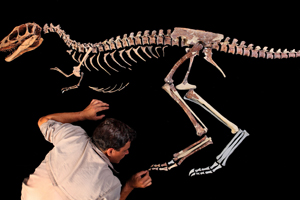Citations
By Lydialyle Gibson
The mind’s eye
When a person looks at an object—a pink flamingo, a red Corvette—the shape and color get processed in separate neural pathways and then relinked, through “neural binding,” to form a unified object. “Color is in the brain,” says Chicago psychologist Steven Shevell. “It is constructed, just as the meanings of words are constructed.” Using a technique called binocular rivalry, in which he showed different images to each eye, pitting the signals against each other, Shevell and Vanderbilt postdoc Sang-Wook Hong, PhD’05, investigated how the brain integrates multiple features of an object (shape, color, location, velocity) into a single whole. They discovered that when the brain loses track of an object’s shape, it retains information about the object’s color, projecting it onto something else. The findings, reported in the October Psychological Science, prove the concept of neural binding.
Petite rex

Paleontologist Paul Sereno taps the toe claw into place on the Raptorex skeleton. Photography by Mike Hettwer.
Before there was T. rex, there was Raptorex, a nine-foot-long version of the prehistoric predator that bore its signature attributes—a huge head, powerful jaws, tiny arms, quick legs, and loping runner’s feet—at one-hundredth the size. It all, says paleontologist Paul Sereno, was packed into a dinosaur that came to “basically our body weight. And that’s pretty staggering.” For an animal’s anatomy to change so little as it evolved into an enormously larger creature is unheard of. Along with five coauthors, Sereno studied the privately owned skeleton of a Raptorex that died in Inner Mongolia 125 million years ago—about 35 million years before the appearance of Tyrannosaurus rex. The researchers published their findings online in the September 17 Science Express.
Like child, like parent
Child care is for parents too. While their children learn to play and make friends, parents make new friends as well, establishing connections to get them through later conundrums, whether it’s finding a pediatrician or coping with a developmental problem. In Unanticipated Gains: Origins of Network Inequality in Everyday Life (Publisher Press), sociologist Mario Small finds that child-care centers benefit both poor and affluent parents, especially moms. On average, mothers who enrolled their children in day care had at least one more good friend than other mothers. Low-income mothers were less likely to fall into homelessness if their children went to child care, even if they’d been homeless in the past. Better-off mothers, meanwhile, were 60 percent less likely to be depressed if they made friends at day-care centers than those who did not make friends. For his research, Small surveyed 300 day-care centers in New York in 2004 and studied data from the Fragile Families and Child Wellbeing Study of 3,500 women from the nation’s 20 largest cities whose children were born between 1998 and 2000.
Risky business
In general, women tend to avoid the risks that men undertake more frequently, but testosterone may provide an equalizer. Studying the connection between testosterone and high-risk financial careers, Chicago Booth economist Luigi Zingales, comparative human-development professor Dario Maestripieri, and Northwestern University Kellogg School economist Paola Sapienza found that the hormone played an important role for women. The researchers began with a sample of 500 Chicago Booth MBA students; 36 percent of the women chose jobs like investment banking or trading, compared with 57 percent of the men. Higher testosterone levels correlated with greater risk-appetite in women, though not in men. But in men and women with similar testosterone levels, risk-related gender differences disappeared. The findings appeared in the August 24 Proceedings of the National Academy of Sciences.
